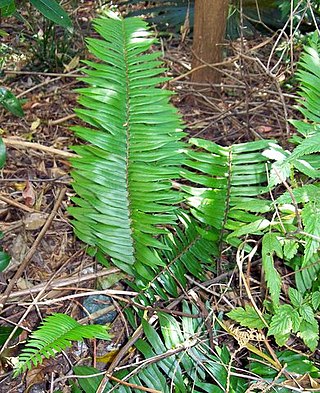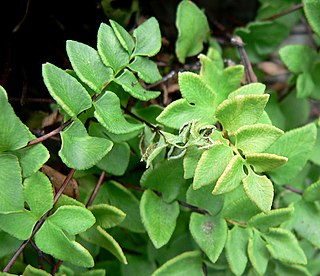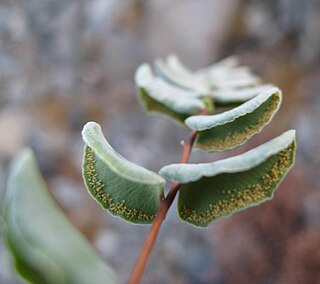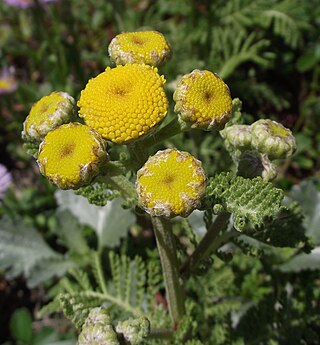
Pellaea is a genus of ferns in the Cheilanthoideae subfamily of the Pteridaceae. The genus name is derived from the Greek word πελλος (pellos), meaning "dark," and refers to the brown stems. Many members of the genus are commonly known as cliffbrakes. They primarily grow in rocky habitats, including moist rocky canyons, slopes, and bluffs.

Polemonium carneum is a plant native to the northwestern United States west of the crest of the Cascade Range, from Washington south through Oregon to the San Francisco Bay Area in California.

Pellaea andromedifolia, with the common names coffee cliffbrake and coffee fern, is a species of cliff brake fern in the Cheilanthoideae subfamily of the Pteridaceae. It is native to California in the United States and Baja California in Mexico.
Horkelia truncata is a species of flowering plant in the rose family known by the common name Ramona horkelia. It is native to the Peninsular Ranges of southern California and northern Baja California, where it grows in the chaparral. This is a clumpy perennial herb forming tufts of erect leaves and stems. The leaves are up to 13 centimeters long and are made up of large oval-shaped leaflets with toothed edges and squared-off, toothed tips. The terminal leaflet of the leaf is sometimes untoothed. The thin stem is 20 to 60 centimeters tall and holds an inflorescence of several flowers. Each flower has short sepals beneath five round white petals. The center of the flower contains a ring of stamens around a patch of up to 80 thready pistils.

Argyrochosma jonesii, known as Jones' false cloak fern, is a species of fern native to the southwestern United States and Sonora, Mexico. It grows on calcareous rocks, and has small, finely-divided leaves with a leathery texture and dark axes connecting the leaf segments. Unlike many members of Argyrochosma, it does not secrete white powder on the underside of its leaves. First described as a species in 1917, it was transferred to the new genus Argyrochosma in 1987, recognizing their distinctness from the "cloak ferns".

Cardamine nuttallii is a species of cardamine known by the common name Nuttall's toothwort. It is native to western North America from British Columbia to California, where it grows in moist mountain habitats.

Lomatium martindalei is a species of flowering plant in the carrot family known by the common names Cascade desertparsley and coast range lomatium, native to western North America.

Pellaea falcata, the sickle fern, is a widespread and common plant, growing in eastern Australia. It is often seen in on the coast and ranges in eucalyptus forest and rainforest. It grows in Tasmania, Victoria, New South Wales, Queensland, and Lord Howe Island.

Pellaea brachyptera is a species of fern known by the common name Sierra cliffbrake. It is native to the coastal and inland mountains of northern California and Oregon, and a disjunct population was discovered in Chelan County, Washington, in 1986.

Pellaea breweri is a species of fern known by the common name Brewer's cliffbrake. It is native to much of the Western United States. It grows in rocky habitat such as cliffs and mountain slopes.

Pellaea bridgesii is a species of fern known by the common name Bridges' cliffbrake. It is native to an area of the western United States from northern California to Idaho, where it grows in rocky granitic cliffs and slopes.

Pellaea truncata is a species of fern known by the common name spiny cliffbrake. It is native to the southwestern United States and northern Mexico, where it grows in rocky areas, such as cliffs and slopes.

Tanacetum camphoratum is a species of flowering plant in the aster family known by the common names camphor tansy and dune tansy. It is native to the Pacific Coast of North America from British Columbia to California, where it grows in sand dunes and other coastline habitat. This species may be known by the synonym Tanacetum douglasii and is often included in Tanacetum bipinnatum. It is a rhizomatous perennial herb with a thick, low-lying stem up to 25 centimeters long, branching to form a mass of vegetation. It is hairy, glandular, and aromatic, with a camphor scent. The leaves are up to 25 centimeters long and thick but featherlike, divided into many narrow leaflets on each side of the main rachis. Each leaflet in turn has many segments along each side, and the segments are usually divided into several small, knobby segments with folded or curled edges. The inflorescence bears up to 15 flower heads, each about a centimeter wide or slightly wider. Each head contains many yellowish disc florets and many pistillate florets around the edges. The latter may have minute ray florets. The fruit is an achene a few millimeters long which is tipped with a small pappus of toothed scales.
Myriopteris allosuroides is a moderately-sized fern of Mexico, a member of the family Pteridaceae. Unlike many members of its genus, its rachides are grooved on the upper surface and largely free of hairs or scales. One of the cheilanthoid ferns, it was usually classified in the genera Cheilanthes or Pellaea until 2013, when the genus Myriopteris was again recognized as separate from Cheilanthes. It typically grows on dry, rocky slopes over acidic, particularly basaltic, rock.

Argyrochosma dealbata, the powdery false cloak fern, is a small fern endemic to the central and southern United States. It grows on calcareous rocks, such as limestone. Its leaves are highly divided, with leaf segments joined by shiny, chestnut-brown axes, and their undersides are coated with white powder, giving the fern its name. First described as a species in 1814, it was transferred to the new genus Argyrochosma in 1987, recognizing their distinctness from the "cloak ferns".
Argyrochosma connectens is a small cheilanthoid fern endemic to Sichuan, China. It is the only member of its genus known from Asia. Relatively rare, it is found growing in the crevices of limestone rocks in hot, dry valleys. The species was long classified in the genus Pellaea, but after a phylogenetic study in 2015 was transferred to Argyrochosma.

Argyrochosma fendleri, Fendler's false cloak fern, is a fern known from the western United States and northwestern Mexico. It grows in rocky habitats, and is distinguished from other members of the genus by its zig-zag leaf axes. Like many species in the genus, it bears white powder on the underside of its leaves. First described as a species in 1851, it was transferred to the new genus Argyrochosma in 1987, recognizing their distinctness from the "cloak ferns".
Argyrochosma incana, the hairy false cloak fern, is a fern known from the southwestern United States through Mexico to Guatemala, and from a disjunct population in the Dominican Republic. It grows on rocky slopes and steep banks, often in forests. Like many of the false cloak ferns, it bears white powder on the underside of its leaves. First described as a species in 1825, it was transferred to the new genus Argyrochosma in 1987, recognizing their distinctness from the "cloak ferns".
Argyrochosma formosa is a fern known from eastern and central Mexico and Guatemala. It grows on rocky slopes, particularly on limestone. Unlike many members of the genus, it lacks white powder on the underside of its leaves. First described as a species in 1842, it was transferred to the new genus Argyrochosma in 1987, recognizing their distinctness from the "cloak ferns".

Argyrochosma limitanea, the southwestern false cloak fern, is a species of fern native to the southwestern United States and Sonora, Mexico. It grows on calcareous rocks, and has small, finely-divided leaves with a leathery texture, dark axes connecting the leaf segments, and a heavy coating of white powder on the undersurface. It reproduces apogamously; two subspecies are recognized, which may have originated independently through the hybridization of other taxa not yet discovered. First described as a species in 1919, it was transferred to the new genus Argyrochosma in 1987, recognizing their distinctness from the "cloak ferns".















